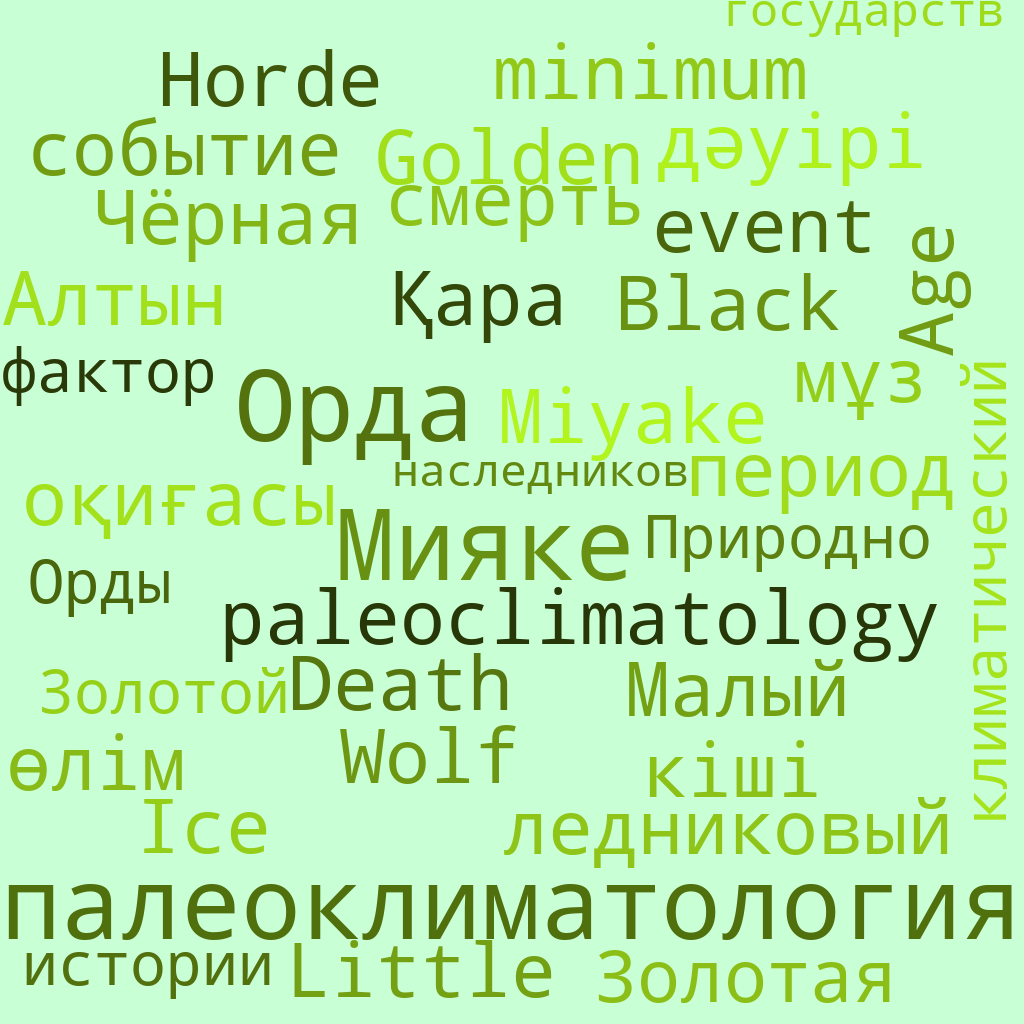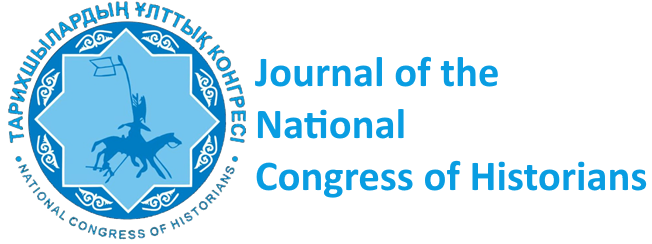Природно-климатический фактор в истории Золотой Орды и государств-наследников
Научная статья
Ключевые слова:
палеоклиматология, Малый ледниковый период , событие Мияке , Чёрная смерть , Золотая ОрдаАннотация
В данной статье рассматривается влияние природно-климатического фактора на историю Золотой Орды и государств-наследников. В российской историографии в следствии относительного небольшого числа письменных источников. Достаточно давно сложились практика использовании в исторических исследованиях данных, полученных в ходе палеоклиматологических и палеогенетических исследований. В исследовании был широко реализован такой междисциплинарный подход. Комбинация данных, взятых из различных письменных источников, позволила закрыть некоторые лакуны в истории средневековых тюркских государств. Предложенная статье концепция экономико-культурных политий, позволила обосновать закономерность появление на пространствах Евразии Золотой Орды. Причем не последнюю роль в последующих политических процессах сыграли «Чёрная смерть», повторные вспышки чумы и других чумоподобных эпидемий, вызванные Малым ледниковым периодом масштабный голод и падежи скота. В условиях масштабного похолодания XIV – XVI вв. исчезновения политического, технологического и культурного лидера региона Золотой Орды явилось стало закономерным результатом. Применение данных палеоклиматических исследований позволило хронологически очертить основные этапы этого процесса. Возрастание или падение роли во второй половине XV – начала XVI вв. того или иного наследника Золотой Орды был во многом предопределен успехом адаптации своей военной стратегии к быстро меняющемся климатическим условиям. Поэтому одним из важнейших факторов становится преодоление массовое сокращение населения засчёт технологического перевооружения и создание эффективной системы управления. Особенно это ярко проявилось в московско-казанском противостоянии. Не смотря на численное и технологическое превосходство над татарских оппонентом, Московского государство вынуждено было отказаться от совершения масштабных походов. Постепенно перейдя к тактике возведения на захваченных территориях новых укреплений и проведению в зимний период в глубине вражеской территории рейдовых операций. Казань вследствие, близости к ресурсной базе, даже не смотря на более архаичную систему управления и перманентный политический кризис, смогла достаточно длительный период эффективно отражать московскую экспансию. Большую роль в этом процессе сыграли наступившие в начале XVI в. природно-климатические изменения обострили зависимость противоборствующих сторон от имеющихся в наличии ресурсов. Наступившее потепление заставило Московское государство вернуться к тактике организации больших походов. Однако, без консолидации всех имеющихся в наличие ресурсов и возведения новых опорных пунктов в Поволжье одержать победу в противостоянии с Казанью и в Поволжье было бы невозможно.
Скачивания
Библиографические ссылки
Bacci M. La popolazione nella storia D’Europa. Roma-Bari, 1998. 306 p. (in Italian)
Bailie M.G.L. New Light on the Black Death: The Cosmic Connection. Tempus. 2006. 224 p. (in English)
Belich J. The World the Plague Made: The Black Death and the Rise of Europe. Princeton University Press. 2022. 640 p. (in English)
Benedictow O.J. The Black Death 1346 – 1352: the complete history. Woodbrige. 2004. 433 p. (in English)
Benedictow O.J. The Complete History of the Black Death. Melton: Boydell & Brewer, Incorporated. 2021. 1058 p. (in English)
Biraben, J.-N. Les hommes et la peste en France et dans les pays européens etméditerranéens. Paris, Mouton. 1975. Vol.1. 480 p. (in French)
Brückner E. Klimaschwankungen seit 1700: nebst Bemerkungen über die Klimaschwankungen der Diluvialzeit. Geographische Abhandlungen. 1890. Bd. 14. 343 p. (in German)
Büntgen U. et al. Tree rings reveal globally coherent signature of cosmogenic radiocarbon events in 774 and 993 CE. Nature Communications. 2018. Vol.9, рp. 1–7. https://doi.org/10.1038/s41467-018-06036-0 (in English)
Camenisch Ch., Keller K.M. et al. The 1430s: a cold period of extraordinary of extraordinary internal climate variabillity during the early Spörer Minimum with social and economic impacts in north-western and central Europe. Climate of the Past. 2016. Vol.12, no.11, рp. 2107–2126. DOI: https://doi.org/10.5194/cp-12-2107-2016 (in English)
Campbell B.M.S. The Great Transition: Climate, Disease and Society in the Late-Medieval World. Cambridge: Cambridge University Press. 2016. 463 p. (in English)
Cantor N.F. In the wake of the Plague: The Black Death and the World it Made. New York. 2001. 256 p. (in English)
Cohn S.K.Jr. The Black Death: End of a Paradigm. The American Historical Review. 2002. Vol.107, no 3, рp.703−738. (in English)
Diamond Ja. Guns, Germs, and Steel: The Fates of Human Societies. W.W. Norton. 1997. (in English)
Häser H. Geschichte der epidemische Krankheiten. In: Lehrbuch der Geschichte der Medicin und der epidemischen Krankheiten. Jena. 1865. Bd. 1–3. (in German)
Herlihy D. The Black Death and the Transformation of the West. Cambridge, MA Harvard: University Press. 1997. (in English)
Kelly J. The Great Mortality: An Intimate History of the Black Death, the Most Devastating Plague of All Time. Harper Collins Publishers. 2005. (in English)
Lien-teh Wu, Chun J.W.H., Pollitzer R., Wu C.Y. Plague. A Manual for Medical and Public Health Workers. Shanghai. 1936. (in English)
McNeill W.H. Plagues and Peoples. New York. 1976. 368 p. (in English)
Miyake F., Nagaya K., Masuda K., Nakamura T. A signature of cosmic-ray increase in AD 774–775 from tree rings in Japan. Nature. 2012. Vol.486, iss.7402, рp. 240–242. https://doi.org/10.1038/nature11123 (in English)
Pollitzer R. Plague. Geneva. 1954. (in English)
Postan M.M. Studies in English Trade in the 15th Century with Eileen Power. Routledge. 2015. 464 p. (in English)
Rasmussen S., Allentoft M., Nielsen K., et. al. Early Divergent Strains of Yersinia pestis in Eurasia 5,000 Years Ago. Cell. 2015. Vol.163, рp.571–582. DOI: https://doi.org/10.1016/j.cell.2015.10.009 (in English)
Schamiloglu U. Preliminary Remarks on the Role of Disease in the History of the Golden Horde. Central Asian Survey. 1993. No.12(4), рp. 447–457. (in English)
Schamiloglu U. Reflections on Regional Variation in the Impact of the Black Death on the Golden Horde. In: Epidemii i prirodnye kataklizmy v Zolotoj Orde i na sopredel'nyh territoriyah (XIII–XVI vv.). Kazan: Publishing House "Shigabutdin Marjani Institute of History of the Academy of Sciences of the Republic of Tatarstan. 2018. Pp. 23–24. (in English)
Schmid B.V., Buentgen U., et al. Climate-driven introduction of the Black Death and successive plague reintroductions into Europe. Proceedings of the National Academy of Sciences. 2015. Vol.112(10), рp.3020–3025. DOI: https://doi.org/10.1073/pnas.1412887112 (in English)
Skott S., Duncan Ch.J. Biology of Plague: Evidence from Historical Populations. Cambrige. 2001. 420 p. (in English)
Slavin Ph. Out of the West: Formation of a Permanent Plague Reservoir in South-Central Germany (1349–1356) and Its Implications. Past & Present. 2021. Vol.252, рp.3–51. DOI: https://doi.org/:10.1093/pastj/gtaa028 (in English)
Slavin Ph. From the Tian Shan to Crimea: Dynamics of Plague Spread during the Early Stages of the Black Death, 1338–1346. Journal of the Economic and Social History of the Orient. 2023. Vol.66, рp.513–627. DOI: https://doi.org/10.1163/15685209-12341601 (in English)
Spyrou M.A., Musralina L., Ruscone G.A.G. et. al The source of the Black Death in fourteenth-century central Eurasia. Nature. 2022. Vol.606 (7915), рp.1–7. DOI: https://doi.org/10.1038/s41586-022-04800-3 (in English)
Spyrou M.A., Tukhbatova R.I, Feldman M., et. al. Historical Y. pestis Genomes Reveal the European Black Death as the Source of Ancient and Modern Plague Pandemics. Cell Host & Microbe. 2016. Vol.19, рp.874–881. DOI: https://doi.org/10.1016/j.chom.2016.05.012 (in English)
Spyrou M.A., Tukhbatova R.I, Wang Ch.-Ch., et. al. Analysis of 3800-year-old Yersinia pestis genomes suggests Bronze Age origin for bubonic plague. Nature Communications. 2018. No.9(2234), рp.1–10. DOI: https://doi.org/10.1038/s41467-018-04550-944 (in English)
Sticker G. Abhandlungen aus der Seuchengeschichte und Seuchenlehre. Band 1: Die Pest. Giessen, A. Töpelmann. 1908, 1068 p. (in German)
Artyuhin Yu.V. Prirodnye kataklizmy kak odna iz prichin «Velikoj zamyatni» v Zolotoj Orde i poyavlenie Azaka. Bosporan studies. 2009. Vol.XVI. Pp. 314–334. (in Russian)
Barash S.I. Istoriya neurozhaev i pogody v Evropy (po XVI v. n.e). Leningrad: Gidrometeoizdat. 1989. 237 p. (in Russian)
Bogolepov M.A. O kolebaniyah klimata evropejskoj Rossii v istoricheskuyu epohu. S prilozheniem materialov, izvlechennyh iz russkih letopisej. Moscow., 1908. 114 p. (in Russian)
Borisenko E.P., Paseckij V.M. Tysyacheletnyaya letopis' neobychajnyh yavlenij prirody. Moscow: Mysl. 1988. 522 p. (in Russian)
Gumilev L.N. Geterohronost' uvlazhneniya Evrazii v srednie veka. Bulletin of the Leningrad University. 1966. No.18, рp.81–90. (in Russian)
Zabolotnyj D.K. Organizaciya i rezul'taty obsledovaniya epidemicheskih ochagov chumy. Archive of Biological Sciences. 1922. Vol. XXII. (in Russian)
Izmajlov I.L. «Chernaya smert'» i krizis v Uluse Dzhuchi: ideal'nyj shtorm. Epidemii i prirodnye kataklizmy. In: Epidemics and natural disasters in the Golden Horde and adjacent territories (XIII–XVI centuries). Kazan: Sh. Marjani Institute of History of the Academy of Sciences of the Republic of Tatarstan. 2018. Рp. 25−48. (in Russian)
Izmajlov I.L. Ekologicheskie kataklizmy. In: The history of the Tatars from ancient times. Vol. III. Ulus of Jochi (Golden Horde) XIII – mid XV century. Kazan: Sh. Marjani Institute of History of the Academy of Sciences of the Republic of Tatarstan, 2009. Pp. 682−686. (in Russian)
Kul'pin-Gubajdullin E.S. Ekologicheskij kriterij civilizovannosti. Zolotaya Orda: fenomen stepnoj gorodskoj civilizacii. Moscow: Moscow Lyceum, 1998. 240 p. 2004. Pp. 127−158. (in Russian)
Nefedov S.A. Istoriya Rossii. Faktornyj analiz. Vol. 1. S drevnejshih vremen do Velikoj smuty. Moscow: Publishing house "Territory of the future". 2010. 376 p. (in Russian)
Khaydarov T.F. Rol' ordynsko-russkoj politii i krupnyh epidemicheskih vspyshek chumy v istorii tatar. In: The Golden Horde heritage. Collection of articles of the International Scientific Conference dedicated to the 700th anniversary of the birth of the medieval poet Seif Sarai and meetings of the triptych. Kazan: Publishing House "Shigabutdin Marjani Institute of History of the Academy of Sciences of the Republic of Tatarstan. 2021. Iss. 4. Pp. 190−226. (in Russian)
Khaydarov T.F. Rubikon Zolotoj Ordy. The Golden Horde Review. Kazan: Publishing House "Shigabutdin Marjani Institute of History of the Academy of Sciences of the Republic of Tatarstan, 2016. Vol.4, no.2, рp.314−335. (in Russian)
Khaydarov T. Epoha «Chernoj smerti» v Zolotoj Orde i prilegayushchih regionah (konec XIII – pervaya polovina XV vv.). Kazan: Publishing House "Institute of History named after Shigabutdin Mardzhani Academy of Sciences of the Republic of Tatarstan, 2018. 304 p.
Khantemirov R.M. Sobytiya Miyake: obzor sovremennogo sostoyaniya issledovanij. Forestry engineering magazine. 2023. Vol.13, no.4(52), рart.2, рp.174−211. DOI: https://doi.org/10.34220/issn.2222-7962/2023.4/23. (in Russian)
Chizhevskij A.L. Zemnoe ekho solnechnyh bur'. Moscow: Mysl. 1976. 240 p. (in Russian)
Chizhevskij A.L. Epidemicheskie katastrofy i periodicheskaya deyatel'nost' Solnca. Moscow: Publishing House of the All-Russian Society of Homeopathic Physicians. 1930. 172 p. (in Russian)
Shamil'oglu U. Vliyanie Chernoj smerti na Zolotuyu Ordu: politika, ekonomika, obshchestvo i civilizaciya. In: The Golden Horde in world history. Kazan: Publishing House of the Shigabutdin Marjani Institute of History of the Academy of Sciences of the Republic of Tatarstan, 2016. Pp. 670-694. (in Russian)
Shamil'oglu U. Chernaya smert' i ee posledstviya In: The history of the Tatars from ancient times: in seven volumes. Vol. III. Ulus of Jochi (Golden Horde) XIII – mid XV centuries. Kazan: Publishing House "Shigabutdin Marjani Institute of History of the Academy of Sciences of the Republic of Tatarstan. 2009. Рр. 686-690. (in Russian)

Загрузки
Опубликован
Выпуск
Раздел
Лицензия
Copyright (c) 2025 Т. Хайдаров

Это произведение доступно по лицензии Creative Commons «Attribution-NonCommercial-NoDerivatives» («Атрибуция — Некоммерческое использование — Без производных произведений») 4.0 Всемирная.


